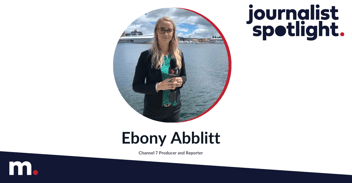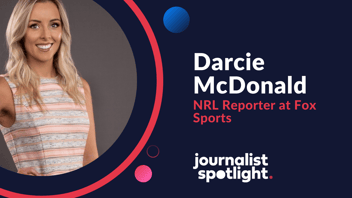Chloe Flynn, Managing Editor of Channel 7’s The Morning Show
Starting off at an independent publishing company whilst at university, Chloe Flynn quickly developed a passion for media in all forms. From there she moved into sub-editing and writing roles at leading women’s titles Dolly and Marie Claire, before making the leap into television in 2007 as part of the inaugural Morning Show team. Since joining Seven, she has worked across a number of shows including Sunrise, Weekend Sunrise and The Daily Edition, as well as prime time specials such as the Royal Wedding. As Managing Editor of The Morning Show, she helps oversee the production of more than 12 hours of live television each week. Chloe is also the author of two books; a novel, Group, and a children’s book, The Day Everyone’s Face Disappeared. You can Tweet her at @chloelflynn.
What makes a press release stand out?
I – like most of my colleagues – get hundreds of emails a day. In fact, right now I have 146 unread emails waiting for me to finish writing this. Out of those hundreds, I reckon 70 per cent are story pitches. And out of that 70 per cent, I’d say I only follow up around 20 per cent. Sure, I’ll skim the subject header, maybe even read the first line or two… But my decision whether or not to pursue the story is made in approximately 10 seconds… harsh, but true! Obviously, content is key. It’s fair to say certain topics are just never going to make their way onto the Morning Show. But a lot of good content can fly under the radar just through a bad pitch. From my perspective, there are a few important things I consider:
Relevance – has there been thought given to the specific style, format and content of the show? There’s nothing more off-putting than a pitch for a segment that’s not actually on our program, or featuring talent who’s on another network. Or the cardinal sin – getting the name of the show, hosts or my name wrong! Also, we’re TV, so there’s not much point pitching a story where there’s no speaking talent or no visuals.
Exclusivity – blanket pitches cut and pasted out to everyone tend to be ignored. Ditto if you’re pitching information or talent that has already been everywhere. We look for unique segments on a first-run, exclusive basis. If there’s a situation where the guest is going to be across a few different platforms, then we need to know exactly what and when, so we can decide whether or not to proceed – transparency is key.
Make it easy for us – with so many pitches to get through, it’s essential you get all the key points across quickly and succinctly – what are you pitching, what does it involve, when is it for, and why is this the best thing that’s going to land in my inbox today? I personally love a bullet point to make it easy to digest, but whatever the format, having all the relevant details ready to go means I can make an informed decision straight away.
Sell, sell, sell! – don’t assume I know or care about your client or talent, really SELL them to me with creative headlines, compelling facts, amazing visuals, or anything else that will make me want to know more. Passion is contagious, if you’re excited about something, then it goes a long way to making others excited too.
When did you decide to work in television and why?
I really fell into TV by accident. 13 odd years ago, I was happily working at Marie Claire when I was approached to discuss a new magazine-style show being developed at Seven. What started as a casual chat on a public holiday, finished with a new job as a Producer on what would become The Morning Show. Although it was a bit of a leap of faith leaving an industry I loved, I relished the opportunity to develop the sort of content I love for a whole new platform – it’s so rare you get the chance to be able to help build something from scratch. Once I experienced live TV, I must say I was hooked – and the rest is history!
What are some of the highlights of working for The Morning Show?
Live TV is like an extreme sport – fast-paced, unpredictable, and utterly addictive. Each day is so wildly different from the next, and I love that even after more than a decade working in it, there’s always something new to learn or experience. Given the broad scope of our content, I’ve been fortunate enough to meet some incredible guests: one minute you’re talking to the Prime Minister, the next you’re trading anecdotes with a 90s sitcom star while trying to get out of the way of a half-naked male dance troupe. Pre-covid, taking the show on the road for an outside broadcast was always a highlight… hopefully we’ll be able to do that again soon. But most importantly, I get to work with some amazingly talented, creative and entertaining people, who make every day at work more fun than is probably legal!
It says on your website that you made your own magazine when you were just nine years old. How did your interests while growing up influence your career choices?
At the risk of exposing how old I am(!), I grew up at a time when magazines were still an incredibly powerful and influential medium, and writing has always been a passion. While I’m eternally grateful for the years I spent working in that industry, the landscape has obviously changed significantly over that time, and my media consumption has evolved along the way. That said, I’ve always been a big consumer of content across the board, and given my somewhat eclectic taste (I happily move between the intellectually stimulating high-brow to the absolute trashiest trash… and everything in between!), I love working on a platform that lets me indulge so many of my different interests.
Tell us about the book you recently published, The Day Everyone’s Face Disappeared.
I created The Day Everyone’s Face Disappeared as a toolkit for families to kickstart the conversation around face masks. Whether by choice or by mandate, masks are officially a part of our everyday lives – but kids are notoriously visual creatures, and rely so much on facial expressions to interpret the world around them. It can be confusing – and even scary – when even those closest to them are reduced to a pair of eyes and a muffled voice. The book combines an easy-to-understand illustrated story with talking points developed in consultation with an education specialist. We live in such strange times, I felt it was important to use my resources as a journalist and a mum, to help kids navigate this new world, even if just in one small way.
What advice can you offer to someone starting out in the media and/or television industry?
The media is evolving at a rapid pace, but I’ve always believed that with change comes opportunity. Be creative, be tenacious, but most of all, be agile.




